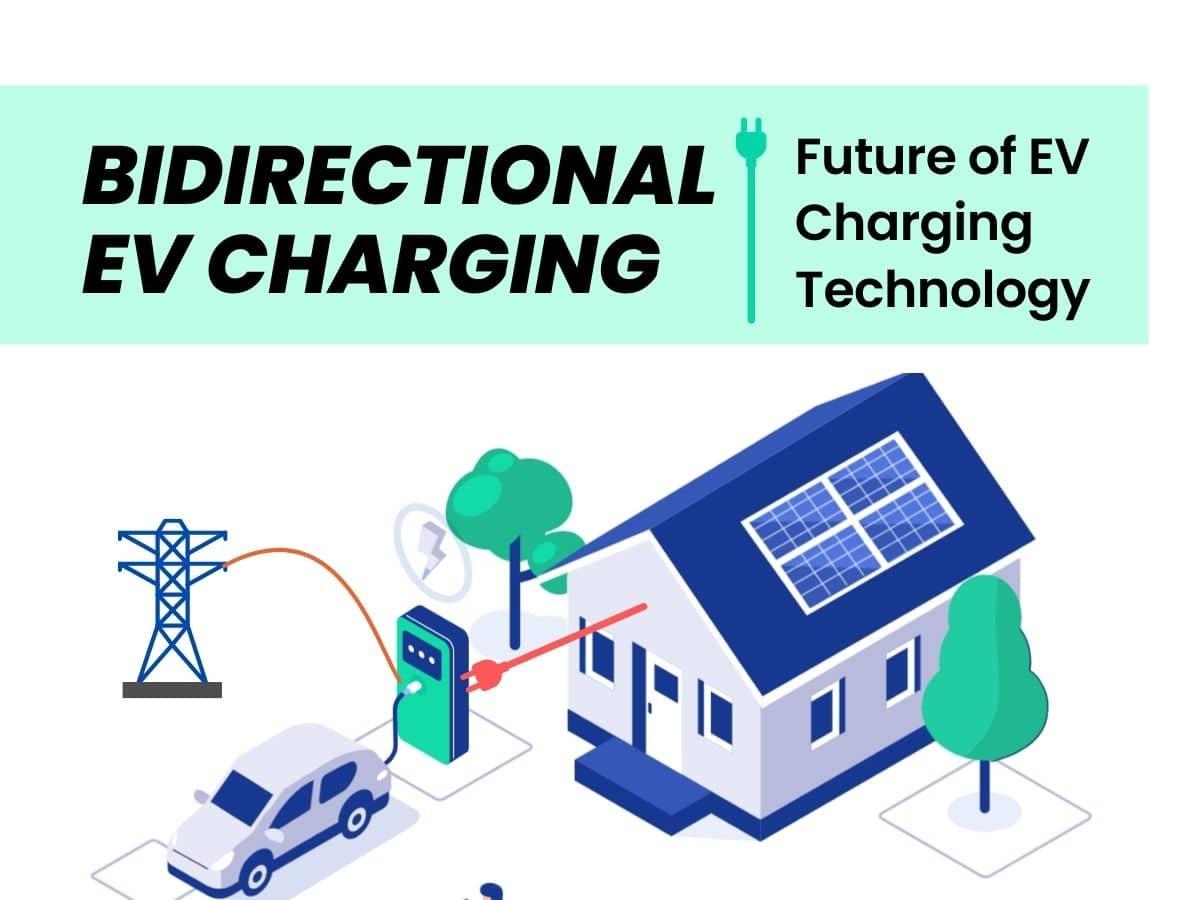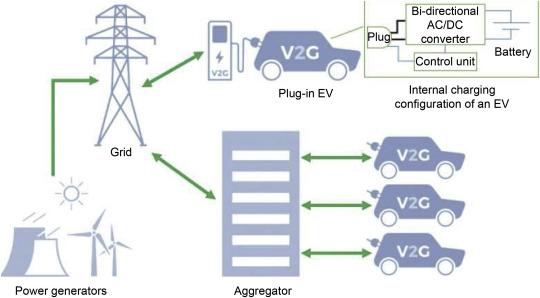First, let’s start with the benefits before talking about what it is. In a nutshell, bidirectional charging can strengthen the Australian power grid, give you access to power on the road, and make your home action-ready against blackouts. In this article, we will explain everything you need to know about bidirectional EV charging technology.

What Is a Bidirectional EV Charger?
To use bidirectional charging, you need to have a bidirectional EV charger installed. Bidirectional EV charging can either power a single load, work as a backup battery for your home, or send energy back to the grid. A normal EV charger, on the other hand, can only send power one way (i.e. to charge your car’s battery), whereas a bidirectional one is just that – two way.
Bidirectional EV chargers may include a built-in DC to AC inverter to perform the bidirectional EV charging process. The charger uses DC power stored in the car’s battery and converts it into AC for use in your house, for example.

What Is Bidirectional EV Charging and How Does It Work?
Traditional EV charging occurs in a single direction. AC power is consumed by the EV charger and delivered to the EV, where it is converted to DC by the on-board EV charger, charging the battery. The difference with bidirectional electric car charging technology is that the charging process occurs in two directions.
V2X electric car charging technology gives EV drivers access to different bidirectional charging applications. The “X” in V2X is a reference to each use:
- G: Vehicle-to-Grid (V2G)
- H: Vehicle-to-Home (V2H)
- V: Vehicle-to-Vehicle (V2V)
- L: Vehicle-to-Load (V2L)
- B: Vehicle-to-Building (V2B)
It is important to note that not all bidirectional EVs are designed for every V2X application. In this section, we explain the different V2X applications.

Vehicle-to-Grid (V2G)
During high peak demands, the power grid is placed under heavy stress. Vehicle to grid charging or V2G is the most important method suited to help the Australian power grid.
Vehicle to grid charging can minimise power fluctuations and reduce the stress placed on the power generation system of the grid during peak demands. As a result, bidirectional electric car charging technology gives the power grid flexibility, resilience, and stability.
During vehicle to grid charging, the bidirectional EV charger converts DC to AC power. The EV battery powers the home and any surplus power is sent to the grid, which is then used by other people in your neighbourhood.
To use vehicle to grid charging you need a bidirectional capable EV charger, a smart metre, registration under a V2G program, and a bidirectional capable EV designed for V2G. Currently, the only EVs capable of V2G in Australia are the Nissan Leaf and the various Mitsubishi plug-in hybrids, but this is rapidly changing with more and more EVs coming onto the market with this capability.
Vehicle-to-Home (V2H) & Vehicle-to-Building (V2B)
You can be prepared against power outages by using a V2X application known as Vehicle-to-Home or V2H charging. This application also has the potential to save you money.
V2H charging extracts DC energy from the EV battery, converting it into AC, and delivers it to your home. During V2H the charger sets the voltage and frequency in a process known as grid-forming.
To use V2H charging, the home needs to be isolated through a manual or automatic transfer switch. You also need a critical service panel with the loads that will be powered, and the corresponding wiring to power those loads. All of this can be set up by a qualified electrician.
There is an additional application closely related to V2H, known as Vehicle-to-Building or V2B. During this process, a commercial building uses stored power at an EV fleet or the EVs owned by workers to power critical loads and reduce the building’s consumption from the grid. Considering the energy stored in an EV fleet (i.e. many batteries across many EVs), and using smart EV charging to take into account Time of Use electricity rates (i.e. cheaper rates during the night) could lead to important energy saving costs for a commercial business.
Vehicle-to-Load (V2L) and Vehicle-to-Vehicle (V2V)
Many EVs can also give you access to power through a generic power plug no matter the location, by using a V2X application known as Vehicle-to-load or V2L.
You can use V2L to power critical loads at the home during an outage by connecting them to a heavy-duty extension cord or a power strip. You can also power most appliances when you’re on the road (i.e. on a camping trip) without the need for a generator!
To use V2L you need a vehicle to load EV charger, which is a simple adapter featuring a male EV plug on one end and a 230V receptacle on the other (i.e. your standard wall plug), but this may vary between EVs. V2L can be used to power other EVs on the road in an application known as Vehicle-to-Vehicle or V2V.
Importance of V2G for the Australian Power Grid

During high peak demands, the power grid is under heavy electrical stress, and increasing the generating capacity via the burning of fossil fuels is not only expensive but environmentally unfriendly. Using electric cars to form a Virtual Power Plant (VPP) makes the power grid more flexible, giving it the ability to deal with power fluctuations and peak demands.
How Can V2H and V2G Save You Money?
Electricity tariffs are more expensive during high peak periods (i.e. the evenings or early mornings), so injecting your car’s power into the grid when subscribed to a V2G program can provide you financial benefits. You can make an additional income if you use that power at low tariffs during the night and give it back at high-peak demand hours.
If you want to buy a battery storage system to use only during blackouts, it might be a good choice to think of V2H. This application can save you money on the battery system and you can power your home for longer since the average EV battery features a larger capacity compared to most smart home batteries.
You can further save money by using solar power to charge your EV. Some electric vehicle chargers such as the Zappi or the Wallbox have a feature that allows them to charge the electric car with solar power. This way you consume solar energy stored in the EV, using it to power the home during high peak demand periods. We do not recommend using V2G with stored solar energy, since solar energy is more valuable to be self-consumed rather than being exported to the grid.
Final Word: V2X and the Future of Bidirectional Charging
Bidirectional charging applications are a great way to save money, have convenience at your fingertips for roadtrips, and be prepared against power outages. These can also help the power grid deal with any type of high peak demands and electrical emergencies, making it more flexible and able to cope with demands as more EVs get charged at home
There are few EVs featuring bidirectional electric car charging technology in Australia, but this will become a standard in the future.
revcharge is an end-to-end EV charging service provider. We take the stress and guesswork out of not only finding an EV charger that meets your needs, but that too of organising a trained technician to install and activate your system. Every EV charger on offer has been carefully evaluated for its performance and features by our specialised team.
Our goal is to save you time and money, while ensuring a quality install that will last you for years to come. All you have to do is answer some quick questions about your home and electric car and send us photos of your switchboard and preferred charger location. We’ll take care of the rest!
Learn more here and get an obligation-free quote today!